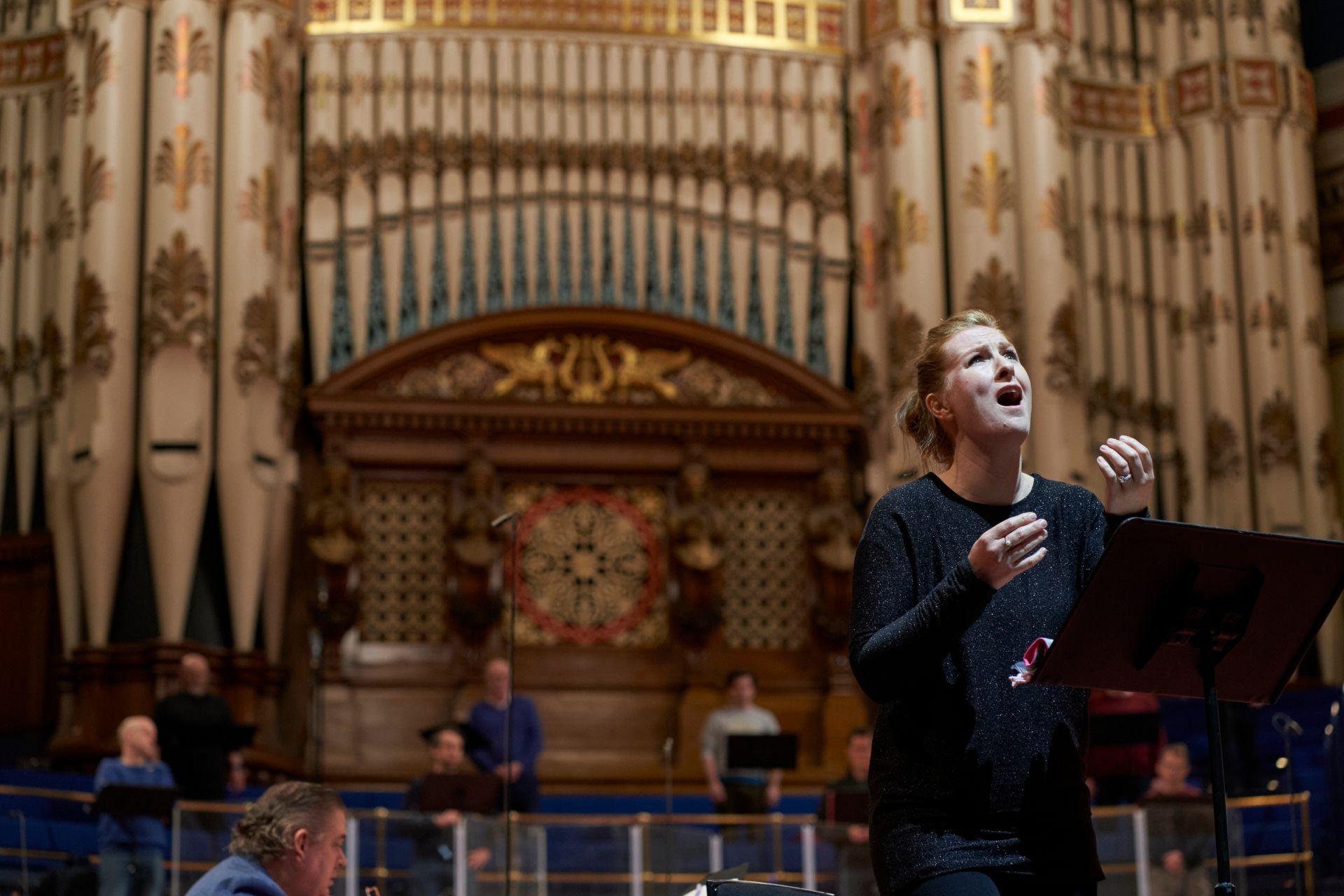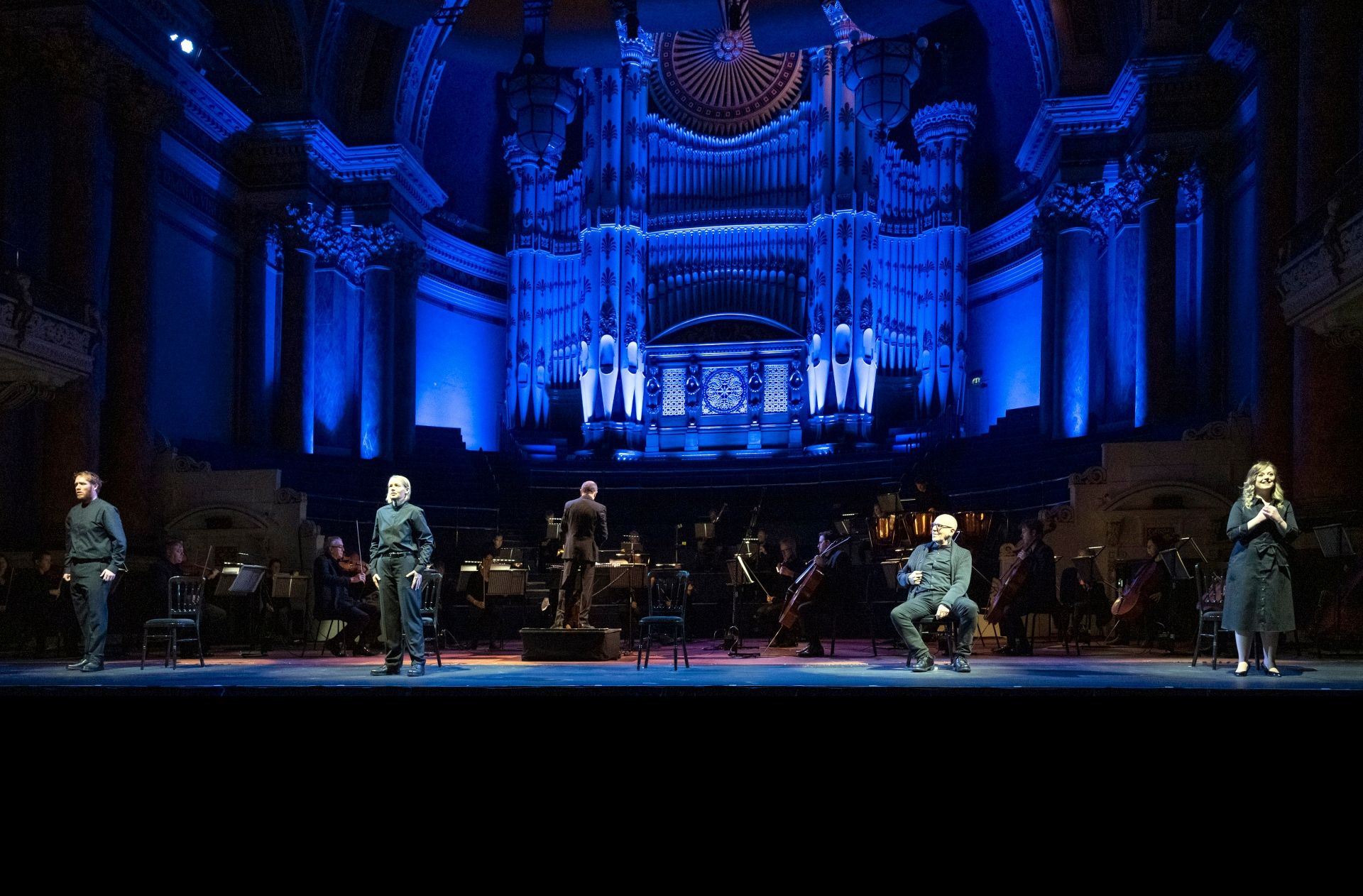A night which begins a little cool soon warms up and proves a real, surprising delight.
Lars Vogt is a pianist clearly comfortable with embracing the new. Strolling onstage in a suit under which he wears, not a shirt and tie, but a black t-shirt, he takes his seat at the Howard Assembly Steinway and begins reading and playing Mozart from score on an iPad. This novelty, as I go on to put in this review, was actually something of a shame, since it seemed to receive vastly more audience attention than the mostly very fine music-making, and in the end proved simply to be a gimmick. However, what did not prove gimmicky was his fantastic, artistic playing.
Mozart, Sonata #2 in F Major, Köchel 280 (1776)
Vogt’s Mozart—particularly in the opening Assai Allegro—is confident and brisk. Although titled Assai (very) Allegro, I found myself wishing that he might have taken more time over some of the most beautiful moments of this movement, of which there are very many. Allegro does, after all, not quite mean fast. Overall the movement is very bright, but also for that, lacks some of the warmth necessary to the very best Mozart. Still, Vogt’s shaping of key dramatic moments, such as the chromatically ascending basslines, is a real pleasure (although the triplets over the top of them make a prime example of the just slightly too hurried performance speed). The sense of hurry is slightly increased by Vogt’s skipping of the second repeat. However, I had to agree with this choice: the second half of this movement is very dramatic, and one would not want the drama to decrease by way of a perfunctory repetition of what is quite a long section.
Although I applaud the drama of the performance, it is clear that not everyone in the audience was so enthralled, since I heard someone after this first movement obnoxiously whispering to their neighbour, “He’s using an iPad to read the music!” Again, I must make a recommendation that the Howard Assembly Room politely remind its audience not to talk during performances, ruining them for everyone else—and vitally, distracting the performer.
The beautiful Adagio also lacks the second repeat. Here, it is a shame: but the lovely decorated repeat of the first section is a delightful recompense. However, again, I feel the tempo is a little stiff in this free-spirited Adagio, although occasionally the necessary warmth is really there. Oddly, the closing Presto comes off as the best and most successful movement. It is full of the warmth and vitality that I missed in the first two movements. I had to conclude that Vogt was by now warming up, both in terms of tone, and playing! The movement is a true Presto, is truly dazzling, and is a true delight.
Janáček, On an Overgrown Path, Pt. 1 (1901–11)
Although the Mozart was overall a little cold, Vogt succeeded consummately in realising both the cold and warmth of Janéček’s weird soundworld, so much harsher than Mozart’s. The first part of the series consists of ten relatively short folksong-like pieces which successfully combine the artlessness and sincerity of folksong style with the ingenuity and manipulation of formal composition, making thereby a very charming and attractive set. In this part of his programme, Vogt excels, showing great skill in the variety of his touch, tonal colour, dynamics and tone. One can tell just from the title of the collection how much of a poetic and imaginative world Janáček tries (and succeeds in so doing) to weave in these pieces: Vogt’s own imaginative take on the varieties of the piano—in his use of pedal, una corde (the soft pedal), weight of the arm, and the individuality and character of each of the fingers—spins Janáček’s poetic and imaginative fairy tale world with utter glory and success.
Interval
Then follows the interval, in which there is much lively discussion about Vogt’s use of an iPad (or Music Kindle) to read the sheet music. I thought it was a great shame that a minor point of means should attract such a great part of the audience attention, especially considering the ticket prices. (You do not pay that much to see someone look at an iPad!) When the discussion turned, then, to the beauty of his playing, I was very much relieved.
No one seemed to share my reservations about the Mozart: but possibly this was because my delirious love of the composer resulted in an impossibly exacting standard for how his music ought (I note, to me only) to be played. Naturally, since most of the audience had seen Sunwook Kim last night (which concert I also reviewed in these pages), comparisons were made. The universal impression was that Vogt offered a much more poetic and artistic performance than Kim’s keyboard-bashing which, while skilled, made his pieces seem more like fireworks, than artworks.
Schoenberg, Six Little Piano Pieces, Opus 19 (1913)
Segue
The real marvel of this brief set, however, was how Vogt exploited the last two notes: the first, again pianissississimo (pppp), sounds the Bb one ninth below middle C, followed by a descent of a ninth to Ab, which takes us beautifully—and without a pause from Vogt—into the opening F minor tonality (the minor relative to Ab major) of Beethoven’s Sonata Appassionata. This was truly remarkably imaginative and ingenious programming in its exploitation of the harmony implicit in Schoenberg’s twelve-tone composition, as a means by which to segue into the tonal world of Beethoven (of roughly a century before). The effect was a shock and a delight. It did not please everyone in the audience, but I deeply appreciated the originality of the thought.
Beethoven, Sonata in F Minor, ‘Appassionata’, Opus 57 (1804–6)
Just as the evening began with an F major sonata in the Classical style, so it ended in F minor in Beethoven’s early Romantic idiom—a nice symmetrical asymmetry, again showing Vogt’s thoughtful programming. Although one audience member told me she felt the opening pianissimo was a little too quiet and reserved, the choice to play it this way made sense to me, given the pianissississimo in the Schoenberg from which Vogt was proceeding. Beethoven’s vast and incomprehensibly great Sonata was a perfect highlight to the evening and showcased all the virtues in Vogt’s piano-playing and musicianship: as in the Mozart, he excelled in communicating the stormier parts of the music in particular, and the tempestuous final movement was utterly gripping and thrilling throughout. Vogt’s clarity was also at its most remarkable here (although it had been almost equally so in the Janáček) as he brought out almost every possible subtlety in the surface of Beethoven’s writing (I doubt whether anyone can pull out all the subtlety in its depths). The speed in the two outer movements was almost break–neck, without ever becoming too aggressive or vulgar. This left the middle movement, the Andante con moto, as something more of a reflective pause, than the great soulful showpiece that it can be at its best. But where we lost one showpiece, we received two more in the fast movements. And indeed, the Andante has its share of demisemiquavers, too.
Encore: Brahms, Intermezzo
Vogt rounded off the evening with a deep graciousness as he dedicated his encore to Dame Fanny Waterman, who was in the audience. Vogt stretched out his hand with a smile, saying “What a remarkable lady!”—Indeed! The choice to end with Brahms, who can never quite be as sweet as I would like him to be, struck me as perhaps not the best, but the Intermezzo was very beautifully played, and contrasted very nicely with the Sturm in the conclusion to the Sonata Appassionata to which we had just finished listening.
To conclude
All in all, a great evening: a slight shame about the cool start, but Vogt more than made up for this in what was to follow. I might add that the novelty of the iPad on the music desk distracted many in his audience from the playing and the pieces—those things that are, after all, the real, proper focus. The audience also generally seemed to wonder, from my conversations, why he read at all, when the vast majority of concert pianists today play their pieces from memory. Whilst (actually) it was pleasant for me to see a pianist read, showing thereby a certain reverence for the musical text altogether missing from the usual piano concerts of today (which are more or less in the Liszt virtuoso tradition, and focus on the performer). The iPad proved too much of a distraction for an audience habituated to the norm. And I might just adjoin a few more words of profound contempt for the whisperers on this night, throughout this competition and at all events generally. I might just once again recommend to the Howard Assembly Room that they gently remind the audience beforehand—perhaps by means of a sign, if no one wants to say it—not to whisper and ruin everyone else’s time, and risk ruining the concentration (and so the work) of the performers.



